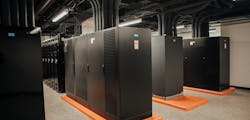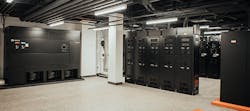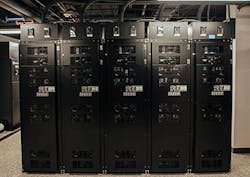Know Your Data Center Deets
The Devil’s in 7 Details
Data centers provide a centralized location where an organization can store, process, and disassemble, data. These centers are highly secured and must be upgraded and renovated without any interruptions to the current service (making them mission critical). When designing and constructing a data center project, success is a result of the team’s ability to address minute details, however challenging they may be.
A colleague and I were discussing data center design and the challenges to meeting a specific objective. While discussing solutions, he made a profound observation: In designing, constructing, and operating a data center, it’s all about the details.
It has become almost second nature for those of us who have worked in the data center design, construction, and operations side, to default to this guiding principle. Of those details, there are a few that consistently pose difficulties to the teams involved with project delivery and execution. It’s important to note, while we list 7 challenges, there are a myriad of other scenarios you must be prepared for when designing and construction data centers.
The Real Deal Challenges
1. Design for Capacity
While it may sound obvious, determining the electrical and mechanical design capacity for the data center is a lot more involved than it appears. I recall working to set those limits when I first worked in operations. The advice I received, regardless of the capacity projection, was likely wrong. Given the varying load profiles of IT equipment and the continuous refresh/updates to rack-mounted equipment, today’s data center must be designed for expandability.
2. Integrate Monitoring From the Start
Power and cooling monitoringshould be a fundamental component of the design. You can’t manage what you can’t measure is a phrase that captures the objective.
Deployment of power monitoring should consider redundant power paths if they are included in the design. Understanding the electrical load is important to forecasting potential expansion in order to meet the business services growth, as well as to understand the impact of fail over scenarios. It is vital in information collection, as are normal state load measurements.
3. Coordinate Electrical and Mechanical
Ensure that the electrical power is installed and meets the mechanical cooling equipment operational objective. For example, where a redundant cooling unit is installed, should the electrical power be provided from a separate power panel? The loss of power to a single power panel suppling both the primary and redundant number of cooling units may result in the loss of all cooling until power can be restored.
4. Understand Controls Availability
What happens if there is a loss in equipment controls? In the case of ducted cooling, will the loss of control to variable air volume (VAV) dampers result in their closure and subsequent loss of essential cooling air to equipment?
It’s important to consider those questions upfront and determine if redundant controls are warranted.
5. Create a Labeling Scheme
- Establish a unique and logical identification for each piece of equipment that includes the identification of electrical and mechanical equipment during the design phase.
- Setting a labeling scheme early in the project provides a smoother transition into the occupancy phase of the project.
- Placing permanent placards on equipment, including such items as valve tags, assists with testing and commissioning, and provides on-going benefits to operations.
- Consider using a color-coding system for separate (ex: A-B) electrical and mechanical delivery paths that are part of the project.
6. Remember Acceptance Testing and Commissioning
Including the performance of testing as part of the construction effort is extremely important. This is more than a check list exercise. It should encompass load testing at design capacity. This may be the only time where evaluating the overall capabilities of the systems installed is possible.
Integrated systems testing (IST) is sometimes difficult to plan and execute, but it is extremely important in evaluating data center performance, not only when everything is normal but when unplanned events occur. Construction projects in an active data center pose unique challenges to testing and commissioning, but the absence of IST leaves the owner with unknowns that must be addressed during occupancy.
7. Plan for Interruptions in Scheduling
This is a sobering, but often true, fact in the construction phase. There are several challenges to staying on schedule; equipment lead times and supply chain issues are only 2 of the obstacles affecting construction. For example, in the past, the delivery date did not change. But, given the current supply chain and labor market, this may not be the case.
If your deadline cannot flex, finding solutions to these issues by redirecting subcontractors’ efforts, planning on extended work schedules, and the possibility of reducing the allotted time for contractor startup, acceptance testing and commissioning.
Establishing an agreement on managing schedule changes should be part of the early project planning discussions. Curtailing startup, testing, and commissioning, efforts often fails to identify issues before the transition from construction to occupancy.
Success Story
Recently, we teamed up with 1623 Farnam to expand their cutting-edge data center in Omaha, Nebraska. The expansion project embraced the 7 principles listed earlier to execute the project on time and within budget.
The data center helps about 50 carriers scale their networks to handle surging traffic flows. The strategically located carrier hotel interconnects and hosts 7 of the Top 13 IP transit providers in the world because it’s a centralized point from which to reach across the US.
During this month of environmental awareness, it’s also important to note that the data center is designed with both chilled water- and air-cooling options. Linn Gowan, VP of business development at 1623 Farnam recently shared his thoughts with Data Center Dynamics saying, "…conventional cooling methods only handle around 4kW per rack, and even advanced air cooling systems lose efficiency when racks hit the 10 to 15kW range (when 64 percent of racks require at least 10kW of power, and 33% of racks house 20kW or more). Although most servers are equipped with air cooling, water is 24 times more efficient than air, and can hold 3200 times as much heat."
He also shared that the global data center liquid cooling market is expected to nearly triple in the period between 2019 and 2024, with a CAGR of almost 23%.
This is the kind of forward thinking needed in the data center industry.Those who make the extra effort to learn from past experiences and industry best practices are rewarded.
Resources and Noteshttps://www.gbabuilders.com/mission-critical
Home
https://www.datacenterknowledge.com/industry-perspectives/liquid-cooling-high-performance-data-centers
https://www.marketsandmarkets.com/Market-Reports/data-center-liquid-cooling-market-84374345.html
For more information, please email [email protected] or visit https://www.gbateam.com/. You can also follow us on Twitter: https://twitter.com/gbateam, LinkedIn: https://www.linkedin.com/company/gba-george-butler-associates-/, and Facebook: https://www.facebook.com/gbateam.
About the Author



